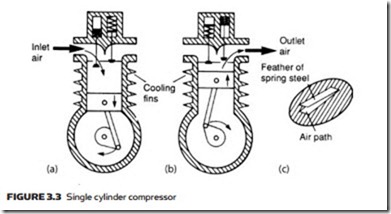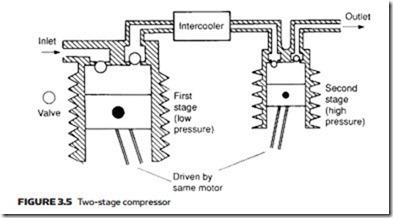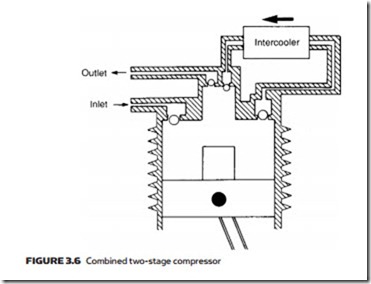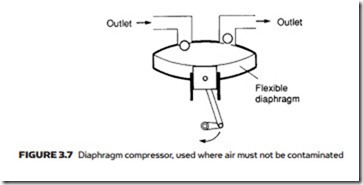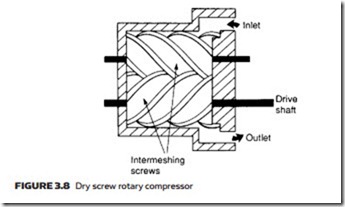compressor types
Like hydraulic pumps, air compressors can be split into positive displacement devices (where a fixed volume of air is delivered on each rotation of the compressor shaft) and dynamic devices such as centrifugal or axial blowers. The vast majority of air compressors are of the positive displacement type.
A compressor is selected by the pressure it is required to work at and the volume of gas it is required to deliver. As explained in the previous section, pressure in the receiver is generally higher than that required at the operating position, with local pressure regulation being used. Pressure at the compressor outlet (which for practical purposes will be the same as that in the receiver) is called the working pressure and is used to specify the compressor. Pressure at the operating point is called, not surprisingly, the operating pressure and is used to specify valves, actuators and other operating devices.
Care should be taken in specifying the volume of gas a compressor is required to deliver. Expression 3.1 shows the volume of a given mass of gas to be highly dependent on pressure and temperature. Delivery volume of a compres- sor is defined in terms of gas at normal atmospheric conditions. Two standards known as standard temperature and pressure (STP) are commonly used, al- though differences between them are small for industrial users.
The technical normal condition is:
P = 0.98 bar absolute, T = 20°C
54 Air Compressors, Air Treatment and Pressure Regulation
and the physical normal condition is:
P = 1.01 bar absolute, T = 0°C
The term normal temperature and pressure (NTP) is also used.
Required delivery volume of a compressor (in M3 min−1 or ft3 min−1, accord- ing to the units used) may be calculated for the actuators at the various operating positions (with healthy safety margins to allow for leakage) but care must be taken to ensure this total volume is converted to STP condition before specifying the required compressor delivery volume.
A compressor delivery volume can be specified in terms of its theoretical volume (swept volume multiplied by rotational speed) or effective volume which includes losses. The ratio of these two volumes is the efficiency. Obviously the effective volume should be used in choosing a compressor (with, again, a safety margin for leakage). Required power of the motor driving the compressor is de- pendent on working pressure and delivery volume, and may be determined from expressions 2.2 and 2.5. Allowance must be made for the cyclic on/off opera- tion of the compressor with the motor being sized for on-load operation and not averaged over a period of time.
Piston compressors
Piston compressors are by far the most common type of compressor, and a basic single cylinder form is shown in Figure 3.3. As the piston descends during the inlet stroke (Figure 3.3a), the inlet valve opens and air is drawn into the cylinder. As the piston passes the bottom of the stroke, the inlet valve closes and the ex- haust valve opens, allowing air to be expelled as the piston rises (Figure 3.3b).
Figure 3.3 implies that the valves are similar to valves in an internal com- bustion engine. In practice, spring-loaded valves are used, which open and close under the action of air pressure across them. One common type uses a ‘feather’ of spring steel which moves above the inlet or output port, as shown in Figure 3.3c.
A single cylinder compressor gives significant pressure pulses at the outlet port. This can be overcome to some extent by the use of a large receiver, but more often a multicylinder compressor is used. These are usually classified as vertical or horizontal in-line arrangements and the more compact V, Y or W constructions.
A compressor which produces one pulse of air per piston stroke (of which the example of Figure 3.3 is typical) is called a single-acting compressor. A more even air supply can be obtained by the double-acting action of the com- pressor in Figure 3.4, which uses two sets of valves and a crosshead to keep the piston rod square at all times. Double-acting compressors can be found in all configurations described earlier.
Piston compressors described so far go direct from atmospheric to required pressure in a single operation. This is known as a single-stage compressor. The general gas law (expression 1.19) showed compression of a gas to be accompa- nied by a significant rise in gas temperature. If the exit pressure is above about 5 bar in a single-acting compressor, the compressed air temperature can rise to over 200 °C and the motor power needed to drive the compressor rises accordingly.
For pressures over a few bar it is far more economical to use a multistage compressor with cooling between stages. Figure 3.5 shows an example. As cooling
(undertaken by a device called an intercooler) reduces the volume of the gas to be compressed at the second stage there is a large energy saving. Normally two stages are used for pneumatic pressures of 10–15 bar, but multistage compressors are available for pressures up to around 50 bar.
Multistage compressors can be manufactured with multicylinders as shown in Figure 3.5 or, more compactly, with a single cylinder and a double diameter piston as shown in Figure 3.6.
There is contact between pistons and air, in standard piston compressors, which may introduce small amounts of lubrication oil from the piston walls into the air.
This very small contamination may be undesirable in food and chemical industries. Figure 3.7 shows a common way of giving a totally clean supply by incorporating a flexible diaphragm between piston and air.
